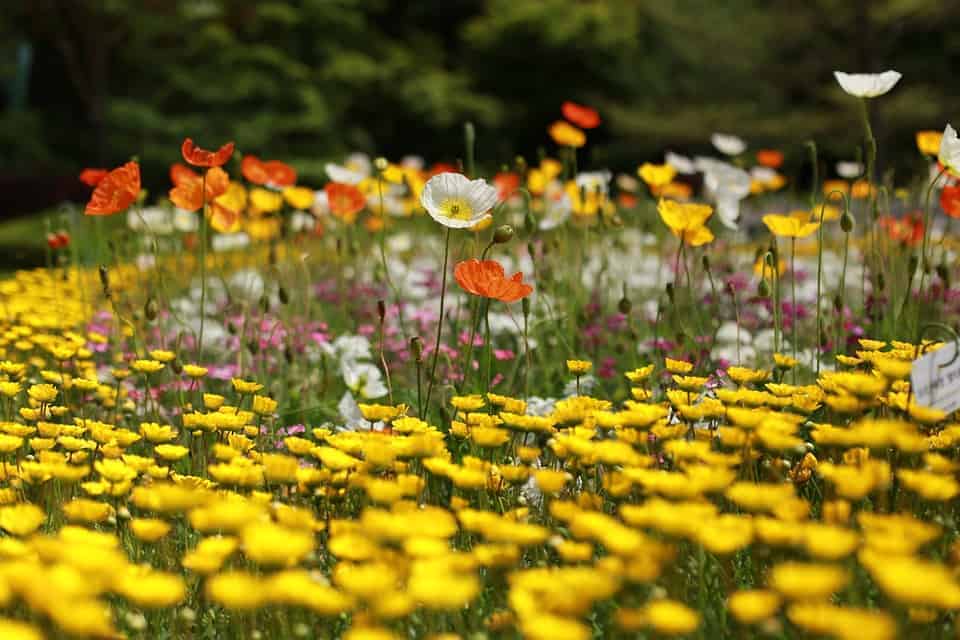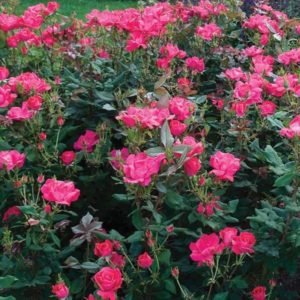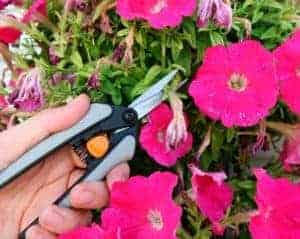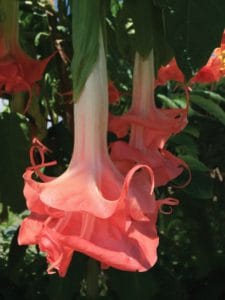
Ah, the lazy days of summer. The hot sun inspires all sorts of fun, but for our gardens, it can take a toll. Notice that your garden, so lush, colorful and beautiful only a few weeks ago, is looking pretty hot and tired these days? Never fear: here are some easy ways to revitalize your garden in summer.
Plant Late Summer – Early Fall Blooming Plants
 When gardeners get that springtime planting bug, we tend to plan our gardens around late-spring and early summer, so our gardens look fantastic April-June, but then wither away come July. Solve that problem now by planting perennials that bloom in late summer through fall for a much-needed second wave of color. Some plants to consider include purple asters, penstemon, and certain long-blooming varieties of roses. Knockout Roses, are a popular low-maintenance choice. You can find a wide selection of them at NatureHillsNursery.com.
When gardeners get that springtime planting bug, we tend to plan our gardens around late-spring and early summer, so our gardens look fantastic April-June, but then wither away come July. Solve that problem now by planting perennials that bloom in late summer through fall for a much-needed second wave of color. Some plants to consider include purple asters, penstemon, and certain long-blooming varieties of roses. Knockout Roses, are a popular low-maintenance choice. You can find a wide selection of them at NatureHillsNursery.com.
Mid-summer can be a very harsh time to plant, however, so follow these tips to give your new plants the best possible start:
- Time your planting to coincide with a few days of cloudy weather or afternoon showers
- Plant only in areas that receive lots of afternoon shade
- Plant early in the morning or late evening
- Water your new plants deeply and often to encourage healthy roots
Freshen up with New Annuals
Nothing brightens up a tired-looking garden than a refreshing round of flowering annuals! Add them to existing flowerbeds for a splash of fresh color, or put them all together in a nice container or two for dramatic effect. Try seasonal favorites like petunias, lobelia and marigolds, or go for something more unique like scarlet sage. Like the perennials, these tender plants need lots of TLC and protection from the hot sun for best results.
Deadhead for More Blooms
 Are your roses and other flowering plants just about spent? Deadheading, which simply means removing old flowers, can convince a lot of them to rebloom! After flowering, plants put all their energy into producing fruit and seeds. By removing the spent flowers, you convince your plants to put all their energy instead into producing more flowers. Deadheading not only results in more color, it also keeps your yard looking nice and tidy, and gives local pollinators a little bumper crop of nectar as well.
Are your roses and other flowering plants just about spent? Deadheading, which simply means removing old flowers, can convince a lot of them to rebloom! After flowering, plants put all their energy into producing fruit and seeds. By removing the spent flowers, you convince your plants to put all their energy instead into producing more flowers. Deadheading not only results in more color, it also keeps your yard looking nice and tidy, and gives local pollinators a little bumper crop of nectar as well.
Deadheading is a very simple process. When the blooms are spent (drying up and losing color) simply pinch them off with your fingers or a pair of small garden scissors. In a couple of weeks, new buds will appear. It’s like getting a bonus wave of color – perfect for brightening up a tired summer garden. While most plants will rebloom for you after deadheading, these are the perennials and shrubs known to benefit the most:
- Garden phlox
- Coneflower (Echinacea)
- Salvia
- Delphinium
- Roses
- Rhododendron
Don’t have the time or energy to deadhead? Consider planting long-blooming plants and reblooming varieties that don’t need deadheading. Popular ones include astilbe, Russian sage and certain varieties of roses.
Add some Summer Flair with Tropical Container Plants

There are many tropical shrubs and trees to consider. Try the ‘Audrey Lea’ Angel’s Trumpet – it’s richly scented, double-petaled blooms will turn your garden space into an exotic oasis. Another fantastic option is citrus trees, such as Meyer lemon, lime or even tangerine. Able to thrive in pots, and capable of withstanding hot, sunny conditions, they are the perfect addition to your deck or patio, and they’ll reward you with delectably tart fruit for your favorite recipe or cocktail. Just be sure to keep an eye on the forecast once fall arrives – these sensitive plants must be brought back indoors once temperatures drop into the 40s.
Prepare for the Fall Planting Season
If it’s just too darn hot to get out and garden, consider spending a relaxing afternoon indoors, planning for exciting fall planting season. That’s right – for the majority of plants, fall is a better time than spring to get planting. Trees, shrubs, perennials, and spring-blooming bulbs prefer to get planted in the fall. It’s a cooler, wetter season in many climates, and the darker days allow new plants to focus their energy on root growth, which is the most important part to getting established. Come spring, you will be amazed by their vigorous growth. Another fall planting bonus: you’ll often get better selection and better prices at local and online nurseries.
Late July through August is a pretty uninspiring time to get out and garden, but with a couple evenings among your plants, you can revitalize your garden in summer, and even help improve it in the coming months. With a little extra effort now, your will be rewarded with a prettier garden, healthier plants, and lots of fall and spring color.



Leave a Reply